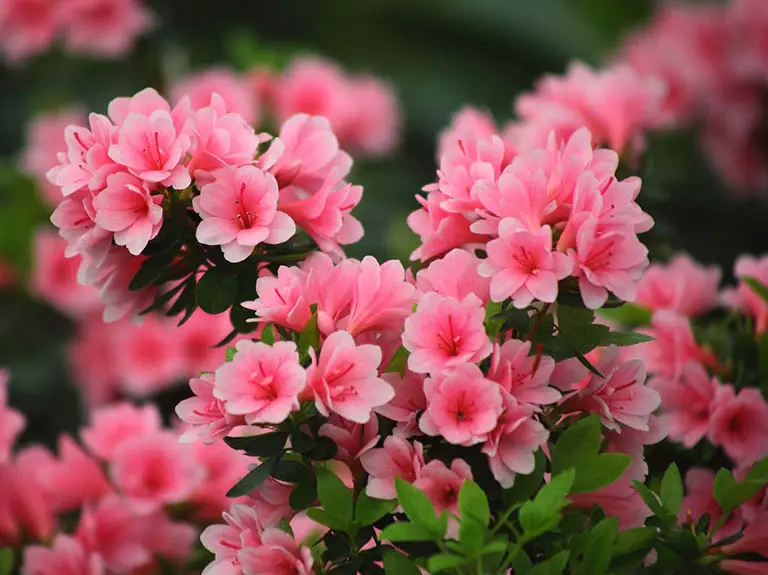Azaleas are a garden favorite for good reason—their brilliant blooms, lush foliage, and graceful form can transform any landscape into a scene of vibrant beauty. Whether you’re dreaming of a woodland garden or a colorful border, planting azaleas the right way is the first step toward long-lasting success.
But how do you plant an azalea to ensure it not only survives but thrives? From choosing the right location to preparing the perfect soil, this guide will walk you through everything you need to know to give your azaleas the best possible start.
Choosing the Right Type of Azalea for Your Garden

Choosing the right azalea variety is key to long-term success. Azaleas fall into two main types: evergreen and deciduous. Evergreen azaleas keep their foliage year-round and are ideal for mild climates (USDA zones 6–9). They tend to be more compact, bloom in early spring, and work well in borders, containers, or foundation plantings. Popular groups include Kurume, Southern Indica, and Satsuki hybrids.
Deciduous azaleas lose their leaves in fall and are better suited for cooler climates (zones 4–7). They often have larger, more fragrant flowers and bloom later in spring or early summer. The Northern Lights series is especially cold-hardy and colorful.
You should also consider bloom time, flower color, plant size, and sun tolerance. Some varieties like the Encore series rebloom in late summer or fall, adding extended seasonal beauty. Compact types suit small spaces, while taller ones shine in woodland settings.
By selecting a variety that matches your climate and garden conditions, you’ll ensure healthier plants and more vibrant blooms year after year.
Finding the Best Time to Plant Azaleas
The best time to plant azaleas is during the cooler months of early spring or early fall, when temperatures are mild and the soil is still workable. These seasons provide ideal conditions for root development without the added stress of extreme heat or cold. In warmer climates, fall planting is often preferred because it gives the roots several months to establish before the next summer. In colder regions, early spring is a better option, as it avoids potential frost damage and allows the plant to settle in before winter.
Avoid planting azaleas during periods of intense heat or drought, as young plants are more vulnerable to moisture loss and transplant shock. If you’re planting in spring, aim to do so after the threat of hard frost has passed but before temperatures climb too high. When planting in fall, try to finish at least 6 to 8 weeks before the first expected freeze to give the roots time to anchor.
By aligning your planting time with favorable weather patterns, you help your azaleas build a strong foundation and encourage healthier, more vigorous growth in the seasons ahead.
Selecting the Perfect Location for Azaleas
Choosing the right planting location is essential for the health and beauty of your azaleas. These shrubs thrive in partial shade, especially in areas that receive morning sun and afternoon shade. Too much direct sunlight can scorch the leaves and reduce bloom quality, while too much shade can limit flowering. Dappled light under tall trees or along the north or east side of a building often provides the ideal balance.
Azaleas prefer well-drained, slightly acidic soil with a pH between 4.5 and 6.0. Avoid low-lying areas where water tends to collect, as standing water can quickly lead to root rot. If your soil is heavy clay or poorly drained, consider planting on a slope or creating a raised bed to improve drainage.
Good air circulation is also important, especially in humid climates, as it helps prevent fungal diseases. Space your azaleas far enough apart to allow for mature growth and airflow between plants. By carefully selecting a location that meets these conditions, you’ll give your azaleas the ideal environment to thrive and bloom beautifully year after year.
Preparing the Soil Before Planting
Proper soil preparation is one of the most important steps to ensure your azaleas thrive. These plants require loose, well-draining, and acidic soil, ideally with a pH between 4.5 and 6.0. If your garden soil is neutral or alkaline, you’ll need to amend it to create a more suitable environment. Start by testing the pH with a simple soil test kit, available at most garden centers or online.
To improve soil structure and acidity, mix in organic materials such as composted pine bark, peat moss, or leaf mold. These amendments not only increase acidity but also help retain moisture without causing waterlogging. Avoid using manure or lime-based compost, as these can raise the pH and make the soil less hospitable for azaleas.
Before planting, loosen the soil to a depth of 12 to 18 inches, breaking up any compacted layers to allow roots to spread easily. Remove large rocks or debris that might obstruct growth. If you’re planting in heavy clay, adding coarse sand or perlite can help improve drainage further.
By taking the time to enrich and prepare the soil properly, you create a healthy foundation that encourages strong root development, better nutrient absorption, and more abundant blooms for years to come.
How to Plant an Azalea Correctly
Planting an azalea properly sets the stage for healthy growth and vibrant blooms. Start by digging a hole that is twice as wide and just slightly shallower than the height of the root ball. This encourages the roots to spread outward rather than downward, which is ideal for azaleas that have shallow, fibrous root systems.
Gently remove the plant from its container and examine the roots. If the roots are tightly bound or circling the bottom, lightly loosen or tease them apart with your fingers to promote outward growth. This step helps prevent the plant from becoming root-bound and encourages better absorption of water and nutrients.
Place the azalea in the hole so that the top of the root ball sits slightly above the surrounding soil level. Planting too deeply can lead to poor oxygen flow and root rot. Once positioned, backfill the hole with your amended, acidic soil. Firm the soil gently around the base of the plant, but avoid compacting it too much, as azaleas prefer well-aerated conditions.
After planting, water thoroughly to settle the soil and eliminate air pockets. Add a 2- to 3-inch layer of mulch around the base, such as pine bark or pine needles, to help retain moisture, regulate soil temperature, and maintain soil acidity. Keep the mulch a few inches away from the stem to prevent rot.
With careful attention to depth, soil condition, and root handling, your azalea will be well-positioned to establish quickly and deliver lush, colorful blooms season after season.
Watering Techniques for Newly Planted Azaleas
Consistent and proper watering is crucial for helping newly planted azaleas establish strong roots. During the first few months after planting, keep the soil consistently moist but not soggy. Azaleas have shallow roots that are sensitive to both drought and overwatering, so balance is key.
Water deeply about once or twice a week, depending on rainfall and temperature. Each watering should soak the soil to a depth of 6 to 8 inches to encourage deeper root growth. Avoid light, frequent watering, which only moistens the surface and weakens root development.
Check the soil regularly by inserting your finger into the ground—if the top 1 to 2 inches feel dry, it’s time to water. In hot or windy conditions, increase monitoring as the soil may dry out faster.
Adding a layer of mulch helps retain soil moisture, reduces evaporation, and protects the roots from temperature swings. Just be sure to keep mulch a few inches away from the stem to prevent rot.
With attentive watering, your azalea will settle in quickly and grow stronger, setting the stage for healthy foliage and vibrant blooms in seasons to come.
Fertilizing Your Azalea for Optimal Growth
Azaleas benefit from light, well-timed fertilization to support healthy growth and abundant blooms. Begin fertilizing only after the plant is established, ideally after its first bloom cycle. Use a slow-release fertilizer formulated for acid-loving plants, which maintains proper pH and provides balanced nutrients.
Apply fertilizer in late spring and, if needed, again in mid to late summer. Avoid fertilizing in fall or winter, as it can trigger tender new growth vulnerable to frost. Always water before and after fertilizing to protect roots and help nutrients absorb.
Watch for signs like pale leaves or weak growth to gauge if additional feeding is needed. With proper timing and the right product, your azalea will thrive season after season.
Monitoring Light and Shade Conditions
Light plays a major role in how well your azalea grows and blooms. Most azaleas thrive in partial shade, especially areas with morning sun and afternoon shade. This balance protects them from harsh midday heat while giving them enough light to produce healthy growth and flowers.
Too much direct sun—especially in hot climates—can scorch the leaves and reduce blooming, while deep shade may lead to leggy growth and few flowers. Monitor how sunlight moves across your planting area throughout the day and across seasons. In cooler climates, azaleas can tolerate more direct sun, which may even boost blooming.
If your azalea isn’t thriving, consider nearby trees or structures that may be blocking or reflecting light. Adjusting the planting location or selectively pruning overhead branches can improve light conditions and help your plant reach its full potential.
Pruning Tips to Maintain Shape and Encourage Blooming
Pruning azaleas at the right time and in the right way helps maintain their natural form, encourages fuller growth, and promotes more abundant blooms. The best time to prune is immediately after flowering, usually in late spring or early summer, as azaleas begin forming next year’s flower buds shortly after blooming. Pruning too late in the season may remove those developing buds and reduce blooms the following year.
Focus first on removing dead, damaged, or diseased branches to improve the plant’s overall health. Then, lightly shape the plant by trimming back overgrown or unruly branches. Avoid heavy pruning unless necessary, as azaleas have a naturally elegant shape that’s best preserved with gentle maintenance.
To encourage bushier growth and more flowers, you can lightly pinch or cut back new shoots after blooming. This stimulates branching without stressing the plant. In older azaleas that have become leggy or sparse, rejuvenation pruning—cutting back one-third of the oldest stems to the base—can help revitalize the plant over time.
Always use clean, sharp pruning tools to prevent the spread of disease, and avoid cutting during wet or humid conditions. With mindful, timely pruning, your azaleas will stay healthy, shapely, and vibrant year after year.
Common Planting Mistakes to Avoid
Avoiding a few common mistakes can make a big difference in how well your azalea grows. One of the most frequent errors is planting too deeply—azaleas should be set with the top of the root ball slightly above ground level to prevent poor drainage and root rot. Another issue is poor soil drainage, especially in clay-heavy or compacted soils. Without proper aeration, azaleas can quickly suffer from waterlogged roots.
Overwatering or underwatering can also harm young plants. Consistent, moderate moisture is key, especially during the first year. Additionally, planting in full sun or dense shade can stress the plant—aim for filtered light or morning sun with afternoon shade.
Finally, skipping soil preparation or failing to check pH can lead to poor nutrient absorption. Azaleas need acidic, organic-rich soil to thrive. By avoiding these mistakes, you set your plant up for long-term success and vibrant blooming.
Long-Term Care for Healthy, Blooming Azaleas
Once established, azaleas are relatively low-maintenance, but consistent care is key to keeping them healthy and blooming year after year. Start by maintaining proper soil acidity—check the pH every few years and amend with soil acidifiers or pine-based mulch if needed. Keeping the soil within the ideal range (pH 4.5–6.0) ensures your azaleas can absorb nutrients effectively.
Continue to water during dry spells, especially in summer or if your plant is still maturing. Mulching annually with pine bark or pine needles helps retain moisture, suppress weeds, and support soil health. Refresh the mulch layer as it breaks down, but always keep it a few inches away from the stem to prevent rot.
Fertilize lightly each spring after blooming with a slow-release formula for acid-loving plants, but avoid overfeeding, which can reduce flowering and lead to leggy growth. Inspect your azaleas regularly for pests such as lace bugs or spider mites—early treatment with insecticidal soap or neem oil can prevent major damage.
Light pruning after flowering helps maintain shape and encourages fresh growth. Remove dead wood, crossed branches, and faded flowers to improve air circulation and plant vigor.
With ongoing attention to soil, water, pruning, and pest control, your azaleas will continue to thrive—rewarding you each spring with lush, colorful blooms and vibrant foliage.
Final Thoughts on Planting Azaleas
Planting an azalea is more than just placing a shrub in the ground—it’s about understanding the plant’s specific needs and setting it up for long-term health. With the right location, soil preparation, and planting method, your azalea will thrive and bring vibrant color to your garden year after year. Whether you’re creating a shaded border, container display, or woodland retreat, azaleas offer a timeless beauty that’s well worth the effort






